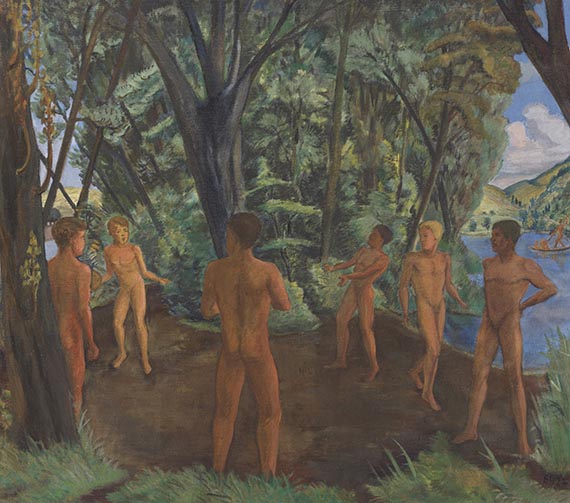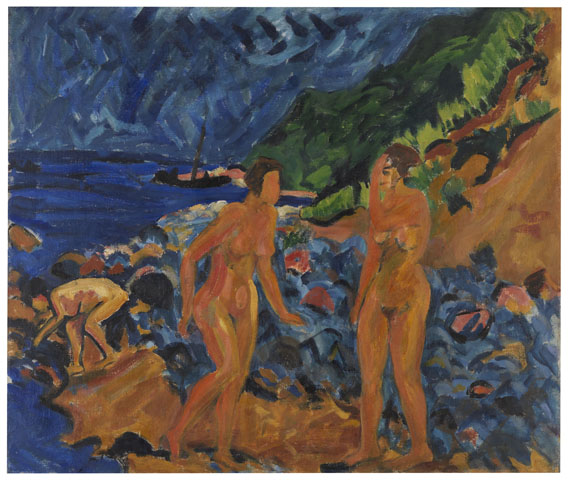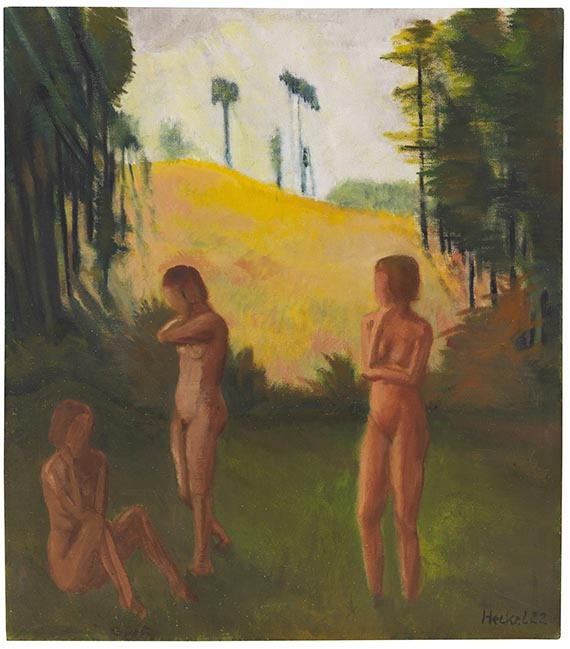Frame image
429
Erich Heckel
Ballspielende auf der Maininsel, 1927.
Tempera on canvas
Estimate:
€ 40,000 - 50,000
$ 42,800 - 53,500
Ballspielende auf der Maininsel. 1927.
Tempera on canvas.
Lower right monogrammed and date. Verso signed and dated. Stretcher signed and titled "Ballspielende" and inscribed "Tempera nicht firnissen!". 110 x 125 cm (43.3 x 49.2 in).
The work is registered in the Hermann Gerlinger Collection with the number SHG 524a. [CH].
• Extensive exhibition history dating back to 1928.
• The motif-related gouache "Ballspielende" from the same year is in the Brücke-Museum Berlin.
• In the year it was created, Siddi and Erich Heckel spent a long time in Würzburg, where they were guests at the estate of the painter Gertraud Rostosky (1876-1959).
• Heckel's work from the mid-1920s takes up individual stylistic principles of New Objectivity: It shows a more naturalistic painting style and the colors now correspond to reality as seen, in contrast to the expressionist phase.
The work is registered in the Erich Heckel Estate, Hemmenhofen on Lake Constance. We are grateful to Mrs Renate Ebner and Mr Hans Geissler for the kind support in cataloging this lot.
PROVENANCE: Erich Heckel Estate, Hemmenhofen.
Hermann Gerlinger Collection, Würzburg (with the collector's stamp, Lugt 6032, acquired from the above in 2015)).
EXHIBITION: Münchener Neue Secession, XIV. Ausstellung, Glaspalast München, 1928, cat. no. 94.
Wohl: Erich Heckel. Gemälde, Aquarelle, Graphik, Galerie Commeter, Hamburg, February 1931 (stretcher with the gallery label).
Erich Heckel, Galerie Ferdinand Möller, Berlin, November 1930, cat. no. 3.
Erich Heckel. Bilder aus den Jahren 1906-1930, Kunsthütte / Städtisches Museum, Chemnitz, March 18 - April 30, 1931, cat. no. 76.
Erich Heckel, Kestner-Gesellschaft Hanover, October 3 - November 3, 1935, cat. no. 14.
Erich Heckel. Werke aus 4 Jahrzehnten, Galerie der Jugend, Hamburg, from November 1, 1947, cat. no. 15.
Erich Heckel, Kaiser-Wilhelm-Museum Krefeld, April 1948, cat. no. 22.
Erich Heckel. Bilder und Drucke 1911-1949, Kunstverein Freiburg i. Br., 1950; Städtische Kunsthalle, Mannheim, 1950, cat. no. 23.
Erich Heckel, Fränkische Galerie, Nürnberg, January 10 - February 9, 1964; Kunst- und Kunstgewerbeverein, Pforzheim, March 8 - April 5, 1964, cat. no. 17.
Erich Heckel, Galerie Günther Franke, Munich, June 18 - August 25, 1973, cat. no. 19.
Brücke-Museum Berlin (permanent loan 1976-1994).
Erich Heckel, Galerie Henze & Ketterer, Wichtrach 1995.
Kunstmuseum Moritzburg, Halle an der Saale (permanent loan from the Hermann Gerlinger Collection, 2001-2017).
Buchheim Museum, Bernried (permanent loan from the Hermann Gerlinger Collection, 2017-2022).
LITERATURE: Paul Vogt, Erich Heckel, Recklinghausen 1965, no. 1927-4 (illu. in black and white).
Andreas Hüneke, Erich Heckel. Werkverzeichnis der Gemälde, Wandbilder und Skulpturen, vol. II (1919-1964), Munich 2017, p. 151, no. 1927-4 (illu. in colors).
- -
Wilhelm Hausenstein, Münchner Neue Secession 1928, in: Deutsche Kunst und Dekoration: illustr. Monatshefte für moderne Malerei, Plastik, Architektur, Wohnungskunst u. künstlerisches Frauen-Arbeiten, no. 63, 1928/29, illu. on p. 5.
Brücke-Museum (ed.), Katalog der Gemälde, Glasfenster und Skulpturen, Berlin 1983, cat. no. 35.
Janina Dahlmanns, Erich Heckels Werk der Zwischenkriegsjahre 1919-1937, Hamburg 2016, pp. 156f.
Called up: June 8, 2024 - ca. 17.38 h +/- 20 min.
Tempera on canvas.
Lower right monogrammed and date. Verso signed and dated. Stretcher signed and titled "Ballspielende" and inscribed "Tempera nicht firnissen!". 110 x 125 cm (43.3 x 49.2 in).
The work is registered in the Hermann Gerlinger Collection with the number SHG 524a. [CH].
• Extensive exhibition history dating back to 1928.
• The motif-related gouache "Ballspielende" from the same year is in the Brücke-Museum Berlin.
• In the year it was created, Siddi and Erich Heckel spent a long time in Würzburg, where they were guests at the estate of the painter Gertraud Rostosky (1876-1959).
• Heckel's work from the mid-1920s takes up individual stylistic principles of New Objectivity: It shows a more naturalistic painting style and the colors now correspond to reality as seen, in contrast to the expressionist phase.
The work is registered in the Erich Heckel Estate, Hemmenhofen on Lake Constance. We are grateful to Mrs Renate Ebner and Mr Hans Geissler for the kind support in cataloging this lot.
PROVENANCE: Erich Heckel Estate, Hemmenhofen.
Hermann Gerlinger Collection, Würzburg (with the collector's stamp, Lugt 6032, acquired from the above in 2015)).
EXHIBITION: Münchener Neue Secession, XIV. Ausstellung, Glaspalast München, 1928, cat. no. 94.
Wohl: Erich Heckel. Gemälde, Aquarelle, Graphik, Galerie Commeter, Hamburg, February 1931 (stretcher with the gallery label).
Erich Heckel, Galerie Ferdinand Möller, Berlin, November 1930, cat. no. 3.
Erich Heckel. Bilder aus den Jahren 1906-1930, Kunsthütte / Städtisches Museum, Chemnitz, March 18 - April 30, 1931, cat. no. 76.
Erich Heckel, Kestner-Gesellschaft Hanover, October 3 - November 3, 1935, cat. no. 14.
Erich Heckel. Werke aus 4 Jahrzehnten, Galerie der Jugend, Hamburg, from November 1, 1947, cat. no. 15.
Erich Heckel, Kaiser-Wilhelm-Museum Krefeld, April 1948, cat. no. 22.
Erich Heckel. Bilder und Drucke 1911-1949, Kunstverein Freiburg i. Br., 1950; Städtische Kunsthalle, Mannheim, 1950, cat. no. 23.
Erich Heckel, Fränkische Galerie, Nürnberg, January 10 - February 9, 1964; Kunst- und Kunstgewerbeverein, Pforzheim, March 8 - April 5, 1964, cat. no. 17.
Erich Heckel, Galerie Günther Franke, Munich, June 18 - August 25, 1973, cat. no. 19.
Brücke-Museum Berlin (permanent loan 1976-1994).
Erich Heckel, Galerie Henze & Ketterer, Wichtrach 1995.
Kunstmuseum Moritzburg, Halle an der Saale (permanent loan from the Hermann Gerlinger Collection, 2001-2017).
Buchheim Museum, Bernried (permanent loan from the Hermann Gerlinger Collection, 2017-2022).
LITERATURE: Paul Vogt, Erich Heckel, Recklinghausen 1965, no. 1927-4 (illu. in black and white).
Andreas Hüneke, Erich Heckel. Werkverzeichnis der Gemälde, Wandbilder und Skulpturen, vol. II (1919-1964), Munich 2017, p. 151, no. 1927-4 (illu. in colors).
- -
Wilhelm Hausenstein, Münchner Neue Secession 1928, in: Deutsche Kunst und Dekoration: illustr. Monatshefte für moderne Malerei, Plastik, Architektur, Wohnungskunst u. künstlerisches Frauen-Arbeiten, no. 63, 1928/29, illu. on p. 5.
Brücke-Museum (ed.), Katalog der Gemälde, Glasfenster und Skulpturen, Berlin 1983, cat. no. 35.
Janina Dahlmanns, Erich Heckels Werk der Zwischenkriegsjahre 1919-1937, Hamburg 2016, pp. 156f.
Called up: June 8, 2024 - ca. 17.38 h +/- 20 min.
From the late 1920s to the early 1930s, Erich Heckel went on numerous journeys that took him to various parts of Germany and its neighboring countries. The new landscape impressions are reflected in many of his paintings. Heckel now turned to a moderately real world of imagination, which henceforth would dominate his works. Despite the more realistic beginnings, the bathing scene on the Main island near Würzburg is reminiscent of the famous bathers on the Moritzburg lakes made during the "Brücke" period. Würzburg and its surroundings provided the artist with a variety of sources of inspiration, which led to a large number of works in pencil, watercolor and oil. A place that had left a special impression on the Heckels. When they had to give up their small apartment and studio in Osterholz on the Flensburg Fjord in 1939, Siddi Heckel wrote to Gertraud Rostosky: "Now we are looking for a new accommodation, but with the idea of turning it into a permanent place of residence. We are very much considering the area around Würzburg. The choice of landscape is determined by the fact that it is to be a working area for the painter, and Würzburg has proved to be the most suitable." (quoted from Hermann Gerlinger, Katja Schneider (ed.), Die Maler der Brücke. Inventory catalog Hermann Gerlinger Collection, Halle 2005, p. 237) Unfortunately, these plans could not be realized due to the war. The addressee, Gertraud Rostosky, was a painter who had established the commune "Neue Welt" (New World), which the artist couple also visited, on her estate near Würzburg. In the first half of the 20th century, the estate was a meeting place and summer residence for artists, writers and intellectuals that became known as such throughout the region. The summer months from 1922 to 1927 were the heyday of the "Neue Welt". During her training in Paris, Rostosky had become acquainted with the German circle of artists at the "Café du Dôme", which led to numerous visits to Würzburg. The hospitable house increasingly developed into a "haven of the arts", hosting artists such as Otto Modersohn and Alfred Kubin, as well as the publisher and Simplicissimus editor Korfiz Holm and Ernst Rowohlt. [SM]
429
Erich Heckel
Ballspielende auf der Maininsel, 1927.
Tempera on canvas
Estimate:
€ 40,000 - 50,000
$ 42,800 - 53,500
Buyer's premium, taxation and resale right compensation for Erich Heckel "Ballspielende auf der Maininsel"
This lot can be purchased subject to differential or regular taxation, artist‘s resale right compensation is due.
Differential taxation:
Hammer price up to 800,000 €: herefrom 32 % premium.
The share of the hammer price exceeding 800,000 € is subject to a premium of 27 % and is added to the premium of the share of the hammer price up to 800,000 €.
The share of the hammer price exceeding 4,000,000 € is subject to a premium of 22 % and is added to the premium of the share of the hammer price up to 4,000,000 €.
The buyer's premium contains VAT, however, it is not shown.
Regular taxation:
Hammer price up to 800,000 €: herefrom 27 % premium.
The share of the hammer price exceeding 800,000 € is subject to a premium of 21% and is added to the premium of the share of the hammer price up to 800,000 €.
The share of the hammer price exceeding 4,000,000 € is subject to a premium of 15% and is added to the premium of the share of the hammer price up to 4,000,000 €.
The statutory VAT of currently 19 % is levied to the sum of hammer price and premium. As an exception, the reduced VAT of 7 % is added for printed books.
We kindly ask you to notify us before invoicing if you wish to be subject to regular taxation.
Calculation of artist‘s resale right compensation:
For works by living artists, or by artists who died less than 70 years ago, a artist‘s resale right compensation is levied in accordance with Section 26 UrhG:
4 % of hammer price from 400.00 euros up to 50,000 euros,
another 3 % of the hammer price from 50,000.01 to 200,000 euros,
another 1 % for the part of the sales proceeds from 200,000.01 to 350,000 euros,
another 0.5 % for the part of the sale proceeds from 350,000.01 to 500,000 euros and
another 0.25 % of the hammer price over 500,000 euros.
The maximum total of the resale right fee is EUR 12,500.
The artist‘s resale right compensation is VAT-exempt.
Differential taxation:
Hammer price up to 800,000 €: herefrom 32 % premium.
The share of the hammer price exceeding 800,000 € is subject to a premium of 27 % and is added to the premium of the share of the hammer price up to 800,000 €.
The share of the hammer price exceeding 4,000,000 € is subject to a premium of 22 % and is added to the premium of the share of the hammer price up to 4,000,000 €.
The buyer's premium contains VAT, however, it is not shown.
Regular taxation:
Hammer price up to 800,000 €: herefrom 27 % premium.
The share of the hammer price exceeding 800,000 € is subject to a premium of 21% and is added to the premium of the share of the hammer price up to 800,000 €.
The share of the hammer price exceeding 4,000,000 € is subject to a premium of 15% and is added to the premium of the share of the hammer price up to 4,000,000 €.
The statutory VAT of currently 19 % is levied to the sum of hammer price and premium. As an exception, the reduced VAT of 7 % is added for printed books.
We kindly ask you to notify us before invoicing if you wish to be subject to regular taxation.
Calculation of artist‘s resale right compensation:
For works by living artists, or by artists who died less than 70 years ago, a artist‘s resale right compensation is levied in accordance with Section 26 UrhG:
4 % of hammer price from 400.00 euros up to 50,000 euros,
another 3 % of the hammer price from 50,000.01 to 200,000 euros,
another 1 % for the part of the sales proceeds from 200,000.01 to 350,000 euros,
another 0.5 % for the part of the sale proceeds from 350,000.01 to 500,000 euros and
another 0.25 % of the hammer price over 500,000 euros.
The maximum total of the resale right fee is EUR 12,500.
The artist‘s resale right compensation is VAT-exempt.




 Lot 429
Lot 429 


